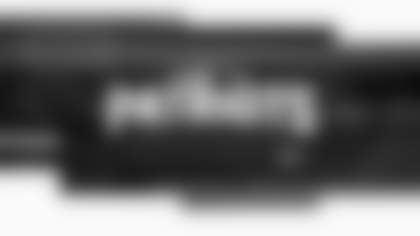Foxboro, MA – The Patriots fell to the Pittsburgh Steelers 21-14 at Gillette Stadium on Sunday, a loss that was mostly of New England's own doing.
Although the Steelers deserve some credit, the Patriots turned the ball over five times, including twice in Pittsburgh's end zone on back-to-back drives, costing themselves multiple scoring opportunities. Over the last 10 seasons, NFL teams are now 5-72 when they turn the ball over five-plus times — a 6.5% win percentage. You cannot expect to win when you turn the ball over that many times, and that's really the story from a disappointing day in Foxboro.
"Turnovers are very hard to overcome. They erase all the good things that you do. They take away momentum. They take away points, give them field position... It was very unfortunate," head coach Mike Vrabel said following the loss. "Ball security comes down to technique. It comes down to other people protecting the guy with the ball, second guy in. Those are all things that we continue to talk about, have talked about, and will talk about. And decision making. Decision making when you have the football in your hand, whether that's a quarterback, whether that's a player that's reaching it, and it gets knocked out. We'll watch the tape, and we'll clearly address the ball security."
The other big-picture storyline for these Patriots is continued struggles at home. Since 2023, New England is now 3-16 at Gillette Stadium, the worst home record in the NFL. Back in January, head coach Mike Vrabel outlined his future goals for the Patriots: "win the AFC East, host home playoff games and compete for championships."
For the Patriots to accomplish those goals, Vrabel's team has to perform better at home. On top of the loss, the Pats also came out flat, falling behind 14-0 early in the second quarter. To their credit, the Patriots dug themselves out of the early deficit, but it's also not a winning formula to put yourself behind by multiple scores as New England did on Sunday.
Ultimately, the Patriots did plenty of good things. They out-gained the Steelers (369-203), had more first downs (26-17), and controlled time of possession. Offensively, the Pats had a 47% play success rate (72nd percentile). While on defense, Pittsburgh only gained one first down over five possessions in the middle quarters. When it's time to turn the page, we can highlight the bright spots. However, to be a sustainable winner in this league, you have to avoid making catastrophic mistakes that wash out the positives. On Sunday, the turnovers did the Patriots in.
Here are eight takeaways as the Patriots drop to 1-2 on the season with a loss to the Steelers in Week 3.
1. Play of the Game: Steelers End the Patriots Game-Tying Drive Attempt with a Big Fourth-Down Stop
Although the self-inflicted wounds were the headline, the Patriots still had a chance to tie the game with a late fourth-quarter possession that ended at the PIT 28.
Following a touchdown drive by the Steelers off the Patriots fifth turnover in the game, QB Drake Maye drove New England into Steelers territory trailing by seven points. After converting their first four attempts on fourth down, the Pats had to go for a 4th-and-1 with the game on the line. This time, the Steelers brought double-edge pressure with nickel CB Jalen Ramsey and safety Juan Thornhill blitzing off the edge, their 22nd blitz of the afternoon.
"I was expecting pressure, expecting to get something out quick. I wish I would have told those guys, 4th-and-1, just try to catch it and get up field. I wish I would have told them that in the huddle. Those little things go a long way," Maye told reporters after the game. "I think they played some blitz trap deal. Shoot, that's just the league."
Maye quickly got the ball out of his hands to slot WR DeMario Douglas, who appeared to have just enough space to pick up the first down by falling forward. Instead, Douglas went backward trying to juke LB Patrick Queen, and was caught trying to elude the first defender by the outside corner (Brandin Echols), crashing down with eyes on the quarterback from his zone drop. Although this loss wasn't all on Douglas, Maye and Vrabel echoed a similar sentiment about getting downhill as quickly as possible after the catch rather than trying to dance out of a tackle.
"It looked like they pressured us, and Drake got the ball out, and again, probably have to just drop step and be able to knife. Know those are going to be bang-bang plays and try to split them and get the 1st down. It's hard to circle around some defenders," Vrabel said.
At the end of the day, it's impossible to know whether or not the Patriots would've scored a touchdown if Douglas had converted on fourth down. Plus, the five turnovers before New England's final drive were the real backbreakers. Still, it's a game of inches, and the late-game heroics in clutch moments that win close games eluded the Patriots once again.
2. Turnover-Worthy Plays Put a Damper on QB Drake Maye's Performance
Like the rest of the offense, Maye had his moments in Sunday's loss, making big plays with his arm and legs to move the Patriots offense into the red zone four times (2-4 in the red zone).
However, after playing a clean game in last week's win over the Dolphins, turnover-worthy plays were an issue for the young quarterback on Sunday. By my count, Maye had four turnover-worthy plays in the loss, including an interception in the end zone to end the first half and a strip-sack where he was trying to do too much by getting the ball out of his hands late in the down. Plus, the Steelers dropped two possible interceptions.
Although the ball was tipped on its way to its intended target (Kayshon Boutte), Maye needed to put more air under the pass to avoid it getting tipped at the line of scrimmage in close quarters: "I could have given him a different ball flight, I think in the back corner of the end zone for a touchdown," Maye said. As the quarterback explained, if Maye lofts the ball to the back corner of the end zone rather than trying to drive it, that's likely a touchdown to end the first half rather than a turnover.
The Patriots need Maye to protect the football better than he did, but there were still some positives in his play on Sunday. New England got their second-year quarterback going in the second quarter once again by moving the pocket. The Pats have become a boot-action heavy offense lately, with Maye keeping the ball on bootlegs to throw downfield or use his legs. Above, his downfield routes were covered, so Maye kept the ball around the corner for a 16-yard gain.
Along with his 45 rushing yards on seven attempts, Maye was still a net-positive by adding +0.16 expected points per drop-back with a 58% success rate. In the traditional stats, Maye was 28-of-37 for 268 passing yards, two touchdowns, and two turnovers for a passer rating of 102.1.
On his best throw of the day, the Patriots converted a third-and-13 on a passing concept that has become a staple for this offense. Pittsburgh played the down in cover three with a four-man rush, and Maye was well protected in the pocket to let Boutte's route develop. The inside route, a crosser by Stefon Diggs, serves as a clear out to open space for Boutte's deep dig to be the second in-breaker into the middle of the field. Maye then rips the throw into the zone void for a 20-yard completion to Boutte.
Another positive play for the young quarterback came on one of the Patriots five fourth-down plays. This time, the play resulted in a touchdown to TE Hunter Henry. New England appeared to correctly anticipate a cover two scheme, with Henry splitting the deep safeties to clear out space for Diggs's route. However, Ramsey and LB Payton Wilson converged on Diggs, leaving Henry wide-open for a huge 16-yard touchdown to tie the game.
Ultimately, Maye's up-and-down play is too reminiscent of his college career and rookie season. There are flashes of brilliant, franchise-level quarterback play. However, to consistently win football games, the Patriots need Maye to be more stable play-to-play and avoid turnovers.
3. Pats Running Backs Struggle with Ball Security in Sunday's Loss to the Steelers
After fumbling the ball seven times last season, lead-back Rhamondre Stevenson put the ball on the ground twice, but Stevenson wasn't the only one to fumble in Sunday's loss.
Along with Stevenson's fumbling struggles, spell-back Antonio Gibson also fumbled in the second half, with the Pats veteran duo combining for three fumbles. At this point, defenses are attacking the football when Stevenson carries the rock, knowing he has fumbling issues. On Sunday, the Pats RB fumbled on the goal-line as he attempted to rush for a game-tying touchdown following a fumble early in the game.
"We identify opportunities, and certainly he had some fumble issues last year. So, it was an agenda item for us," Steelers head coach Mike Tomlin said of Stevenson.
Eventually, the Patriots turned to rookie TreVeyon Henderson to close the game. However, he's had his own issues in blitz pickup, allowing an early pressure on Sunday, a perceived strength of his coming out of college. Most likely, those struggles for Henderson are mental while he learns the Patriots dual-read blitz protection system for running backs and adjusts to the speed of NFL blitzes. Still, a position of strength for this team based on the talent in the room let New England down on Sunday.
"We need his ability, but we also need to take care of the football," Vrabel said of Stevenson. "I'm not really sure 20 minutes after the game what we're going to do, but we need him."
4. Patriots Defense Laments Lack of Opportunities to Rush Steelers QB Aaron Rodgers
One theme over the last two weeks for the Patriots defense is that both Rodgers and Dolphins QB Tua Tagovailoa haven't given the Pats defensive front much time to take over the game. On Sunday, Rodgers' average time to throw was a brisk 2.45 seconds, while the 41-year-old quarterback's average target depth was only 4.6 yards. In all, Rodgers only attempted 31.9% of his passes when he held the ball for over 2.5 seconds (nine total attempts), so the ball came out quickly.
The feeling is that the Patriots pass rush, led by Milton Williams, Christian Barmore, Harold Landry, and K'Lavon Chaisson, can take games over. But opponents are calling quick games, screens, and runs to avoid pressure. Early on, the Steelers ran the ball effectively on the Patriots defense on their opening touchdown drive, but New England mostly cleaned that up. The Patriots need to find ways to let their pass rush eat to make a bigger impact on the game.
5. Patriots Secondary Shadows Steelers Receivers DK Metcalf and Calvin Austin
New England mostly played the matchups versus Austin and Metcalf in Week 3. Free-agent addition Carlton Davis lined up against Metcalf 18 times, or 81.8% of his routes, while captain Marcus Jones had Austin on 61.1% of his routes (11 total). The results were mixed, as Davis and Jones gave up touchdowns to the Steelers receiver duo on go routes. Davis was also called for an iffy 18-yard pass interference penalty. Overall, Metcalf had three catches for 32 yards and a touchdown with a drawn DPI on Davis. As for Austin, the Steelers wideout had two catches for 25 yards and a touchdown with Jones in coverage.
One last note on the Patriots secondary: it appeared that CB Charles Woods replaced CB Alex Austin in the second quarter. Austin was called for pass interference on a third-down play in the red zone, while a defensive holding call on Austin negated a third-down strip-sack by Williams in the second quarter. Austin, who had a strong camp, has struggled to start the season in place of star CB Christian Gonzalez, who was inactive for the third-straight game due to his hamstring injury.
6. Pass Protection was Shaky Based on Initial Viewing of Pats-Steelers
As always, we'll have to review the tape to get a more accurate assessment of the offensive line. However, watching live, the pressure was noticeable, especially early in the game. According to Pro Football Focus's initial charting, Maye was under pressure on 38.3% of his drop-backs, while rookie LT Will Campbell struggled in his matchup vs. Steelers edge rusher Nick Herbig. Herbig, an explosive speed rusher, had seven total pressures on Sunday, while the Pats rookie left side allowed a Cameron Heyward sack on a T/E stunt scheme.
Along with Campbell and Wilson combining to allow 11 total pressures, RT Morgan Moses gave up a sack to Steelers star T.J. Watt. For context, Maye dropped back to pass 47 times, while the Steelers blitzed at an extremely high rate (44.7%). This offensive line has improved from last season, but it's clear that the Pats aren't built to be a high-volume drop-back passing offense yet.
7. Vrabel Goes for it on Fourth Down Five Times, and the Math is on his Side
In the offseason, Vrabel pointed to a successful formula to make in-game decisions, working alongside John "Stretch" Streicher when asked about his decision-making process. Streicher's official title is VP of Football Operations and Strategy, and Stretch is held in high regard in league circles for his grasp of game situations and analytics. On Sunday, the Patriots went for it on fourth down five times, converting four of them, including going for it on 4th-and-1 from their own 15-yard line down 14-7 in the second quarter.
"I just want to be aggressive, want to be decisive and aggressive and give these guys opportunities to win the game. Felt like those were good calls for us. The players executed it. We just weren't able to score off of some of them," Vrabel said of the fourth-down decisions.
Although they likely have their own models, Ben Baldwin's decision-making calculator agreed with Vrabel's fourth-down decisions – even from his own 15-yard line. So far, the Pats have been lockstep with Baldwin's model in terms of their fourth-down decision-making. So, if we had to guess, the Patriots are using analytics to make these decisions.
8. Quiet Day for the Patriots Special Teams Units in Week 3 Loss
After an eventful performance last week, the Patriots didn't attempt any field goals and only punted once due to Vrabel's aggressiveness on fourth down. Rookie K Andy Borregales made both his extra points, which was noteworthy after the first-year kicker missed two extra points in Miami. Another notable takeaway was that the Steelers kickoff coverage unit seemed to win the battle against the Pats returners. Pats kickoff returners TreVeyon Henderson and Antonio Gibson only averaged 23.5 yards per kickoff return (four returns for 94 yards). Vrabel has said numerous times that the returners need to be weapons for this team, so it was notable that their longest kickoff return on four attempts was just 26 yards.
DISCLAIMER: The views and thoughts expressed in this article are those of the writer and don't necessarily reflect those of the organization. Read Full Disclaimer













































